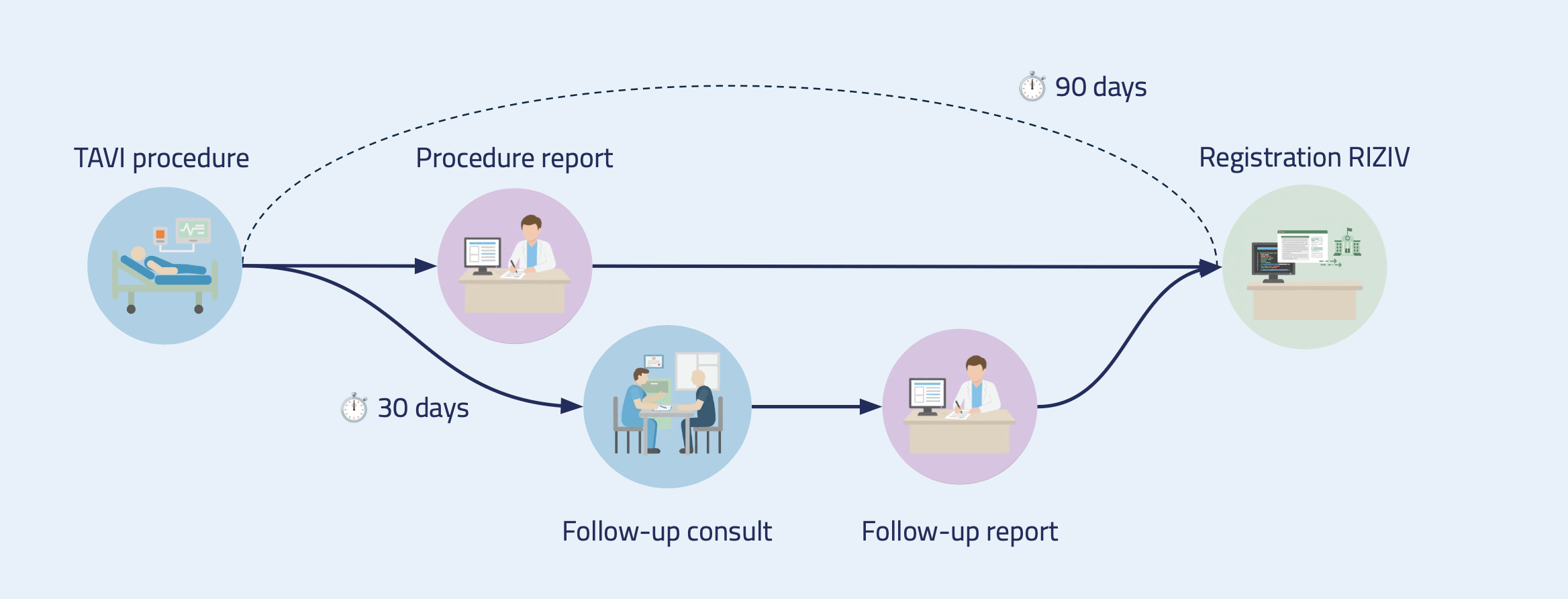Belgian hospitals performing TAVI procedures face a regulatory challenge that directly impacts both clinical workflows and reimbursement. Every transcatheter aortic valve implantation (TAVI) must be registered with RIZIV/INAMI within strict deadlines: 90 days for the procedure report and follow-up documentation. Miss these windows, and the hospital risks losing reimbursement exceeding €12,060 per procedure.
The traditional approach requires cardiologists and supporting healthcare professionals to document each procedure twice: once in their hospital's EHR system for the clinical record, and again in RIZIV/INAMI's registry portal for compliance. This duplicate data entry consumes valuable time, introduces transcription errors, and creates administrative overhead.

The duplicate entry burden
Beyond immediate compliance requirements, the lack of structured data limits operational oversight for cardiac centers performing high volumes of TAVI procedures. How many procedures were completed this month? Which patients require follow-up appointments? Which cases need documentation before the 90-day deadline? This information is scattered across disconnected systems, requiring manual effort to piece together.
Structured data capture solves this by providing real-time visibility into procedure volumes, outstanding follow-ups, and compliance status without manual tracking.
Structured data capture: Document once, use everywhere
Tiro.health A.I. powered forms eliminates duplicate data entry while ensuring regulatory compliance and supporting clinical quality. The platform uses the international FHIR standard as its foundation, creating an ecosystem where clinical documentation automatically generates registry-ready data without additional effort from clinical teams. Besides, procedures/diagnoses are SNOMED-CT coded as defined by the RIZIV Data Collection Definition, ensuring consistency regardless of underlying EHR infrastructure.
Efficient clinical documentation
When a cardiologist begins documenting a TAVI procedure, patient demographics and relevant clinical history automatically pre-populate from existing FHIR resources. Laboratory values, echocardiographic findings, and prior clinical assessments flow into the form without manual searching or re-entry.
The documentation experience prioritizes efficiency through voice input for hands-free documentation, smart presets for common scenarios, intelligent autocomplete that suggests appropriate SNOMED CT codes, and real-time validation that catches errors immediately rather than during post-submission review.

Measurable impact
The transformation delivers tangible benefits across multiple dimensions.
Administrative efficiency
Duplicate data entry disappears from clinical workflows. What previously required separate registry sessions now happens seamlessly during routine documentation, reclaiming hours monthly for patient care activities. The focus of administration is moving from enforcing deadlines to overseeing data quality.
Data quality improvement
SNOMED CT coding ensures semantic consistency, enabling meaningful comparison of outcomes even when different institutions use different terminology in clinical practice. Mandatory field completion prevents gaps that often occurred with manual registry entry. Real-time validation catches errors immediately, reducing rework and submission delays.
Research enablement
The same FHIR QuestionnaireResponses supporting registry compliance flow into research databases without additional data collection effort. Health care professionals contribute to outcome studies and quality initiatives simply by documenting care in their normal workflow.
Technical foundation: Standards-based architecture
Tiro.health's platform implements the FHIR Structured Data Capture implementation guide, ensuring compatibility with emerging international standards.
This compliance means that as Belgium's healthcare infrastructure evolves towards FHIR-based interoperability aligned with European Health Data Space requirements, existing implementations continue working without costly redevelopment.
The platform's privacy by design architecture ensures that sensitive patient information stays within hospital systems while enabling appropriate data sharing for registries and quality dashboards.
Looking forward: Expanding implementation
The European Health Data Space regulations will mandate FHIR-compliant data exchange for cross-border care and secondary use scenarios. Hospitals investing in FHIR infrastructure now position themselves for regulatory compliance while gaining immediate operational benefits.
Through implementations like the TAVI registry initiative, Tiro.health continues supporting Belgian healthcare's digital transformation, making compliance simpler, quality improvement systematic, and patient care better.
Ready to eliminate duplicate TAVI documentation at your cardiac center?
Contact our team to discover how structured data capture can transform your registry compliance while improving clinical workflow efficiency.



